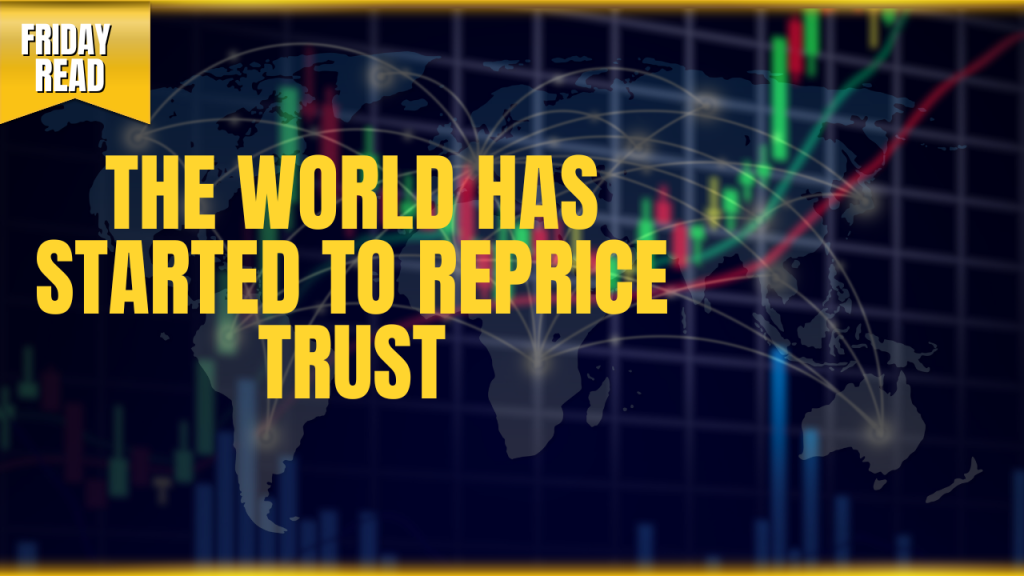
Gold and silver both reached record highs this week, briefly pausing only after crossing thresholds that many investors had once assumed would hold for years. Prices have eased since, but something significant has changed in the collective psychology of markets. The ceiling has gone. What was once a speculative hope has become accepted fact, and that shift invites a deeper reflection. Investors are beginning to realise that the price of gold tells a story that extends far beyond the metal itself; it is a barometer of trust, a reflection of confidence in political and monetary institutions, and a measure of how secure the global financial order now feels.
Is the world losing faith in America?
In our conversations with clients over the past few days, the most striking emotion has not been excitement but unease. These are people who have long recognised that financial systems are fragile, that debt cannot expand forever, and that the stability of fiat currency depends on the restraint of those who manage it. They bought gold as protection against exactly the kind of instability that now surrounds us. Yet the sight of their insurance policy suddenly rising in value has left many of them disoriented. The analogy is familiar but apt: one takes comfort in owning home insurance, yet no one wants to see the house actually catch fire.
That discomfort captures something profound about this moment. The rally in gold and silver is not a celebration of prosperity but a subtle referendum on trust. When real assets rise against paper ones, it is rarely a sign of exuberance. It is an expression of doubt. What markets are really repricing is not gold itself but belief, belief in the competence of governments, the independence of central banks, and the idea that the promises embedded in our financial system can stretch indefinitely without consequence.
The illusion of control
For much of the past decade, investors were assured that inflation had been conquered, that the system was resilient, and that money creation could proceed indefinitely so long as the right words were said in the right tone by the right central banker. That illusion carried us through negative rates, pandemic stimulus, and an extraordinary expansion of public debt, all under the comforting belief that stability was permanent. Yet as gold and silver now climb to new highs in a world where inflation remains stubborn, deficits show no sign of restraint, and borrowing costs are no longer negligible, that narrative has fractured. The models that once explained everything no longer explain anything.
Even the most conventional commentators are beginning to discuss what these prices imply about the health of the global order. Paul Krugman, who has never been a friend of gold, wrote recently about the way markets are beginning to question America’s political and fiscal credibility. In reflecting on investors’ behaviour, he cited hedge fund billionaire Ken Griffin, who warned that rising gold prices might reflect the world’s declining faith in the United States. Krugman’s focus was not on the merits of gold but on what such moves reveal about trust, a theme that runs uncomfortably close to the very signals the metal has long embodied.
For decades, the modern economy has been built on the management of promises. Governments borrow today against tomorrow’s growth. Central banks manage expectations rather than value. Investors accept that the purchasing power of their assets will erode gradually but predictably. This architecture depends entirely on confidence, on the assumption that the system’s managers know what they are doing and that the structure will hold. When that belief weakens, gold reappears as the collateral of last resort.
A mirror for money
Gold, of course, does not change. It does not yield or promise, and it cannot default. It simply reflects the strength or weakness of the currency against which it is measured. To describe gold as rising is to misunderstand the event. It is the value of money that is falling in relation to something that does not depend on credit, policy or trust.
History offers countless examples of this phenomenon. The Roman denarius, the French assignat, the British pound at its imperial height, each carried the aura of permanence until the system that supported it overreached. The lesson, repeated through centuries, is that money based on faith alone can never defy the gravity of human behaviour indefinitely.
The search for solidity
Across the emerging world, central banks have been increasing their gold reserves. They are not doing this for ornament. They are doing it because the definition of safety has changed. The freezing of reserves, the politicisation of currencies, and the erosion of fiscal restraint have all prompted a quiet shift away from assets that depend on goodwill toward those that exist on their own terms.
Private investors are experiencing the same realisation. Gold’s ascent is not an invitation to speculate; it is a reminder that value grounded in tangibility is once again in demand. The same applies to silver, whose industrial use only reinforces its role as something physical and finite in an increasingly abstract system.
This environment tests conviction. When the asset one holds for protection begins to outperform, it can create a sense of discomfort rather than triumph. We are conditioned to view rising prices as speculative, but in this instance the movement is reflective. It shows that confidence is thinning and that the concept of stability itself is being revised.
The insurance you never wanted to claim
The ascent of gold and silver is not a victory for their holders. It is a sign that the system is under strain. Precious metals perform best when other assets fail to inspire confidence. Their strength is often the mirror image of fragility elsewhere.
This week’s price action is therefore not about metals or markets, but about meaning. The world is repricing trust. It is questioning whether the financial order can continue to expand without accountability and whether the very idea of money as an endlessly elastic instrument has reached its natural limits. Gold is not making a statement; it is quietly recording one.
For investors, the question is not whether to buy more, but whether they truly understand what they already hold. In uncertain times, ownership of something real is not speculation. It is a form of memory, a recognition that value, if it is to endure, must rest on something that cannot be printed, decreed, or promised into existence.
Buy Gold Coins

Buy gold coins and bars and store them in the safest vaults in Switzerland, London or Singapore with GoldCore.
Learn why Switzerland remains a safe-haven jurisdiction for owning precious metals. Access Our Most Popular Guide, the Essential Guide to Storing Gold in Switzerland here.
Receive Our Award Winning Market Updates In Your Inbox – Sign Up Here





